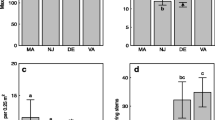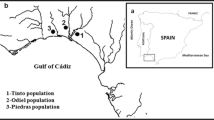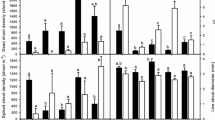Abstract
Salinity and tidal inundation induce physiological stress in vascular plant species and influence their distribution and productivity in estuarine wetlands. Climate change-induced sea level rise may magnify these abiotic stressors and the physiological stresses they can cause. Understanding the potential of invasive plants to respond to predicted salinity increases will elucidate their potential niche breadth. To examine potential phenotypic plasticity and functional trait responses to salinity stress in the invasive cordgrass Spartina densiflora, we collected rhizomes from four invasive populations occurring from California to Vancouver Island, British Columbia on the Pacific Coast of North America. In a glasshouse common garden experiment, we measured plant traits associated with growth and allocation, photosynthesis, leaf pigments, and leaf chemistry and calculated plasticity indices across imposed salinity treatments. Fifteen of 21 leaf chemistry, pigment, morphological and physiological traits expressed plastic responses to salinity. When averaged across all measured traits, degree of plasticity did not vary among sampled populations. However, differences in plasticity among populations in response to salinity were observed for 9 of 21 measured plant traits. Leaf chemistry and adaxial leaf rolling trait responses demonstrated the highest degree of plasticity, while growth and allocation measures were less plastic. Phenotypic plasticity of leaf functional traits to salinity indicates the potential of S. densiflora to maintain invasive growth in response to rising estuarine salinity with climate change.





Similar content being viewed by others
References
Abbas AM, Lambert AM, Rubio-Casal AE, de Cires A, Figueroa E, Castillo JM (2015) Competition from native hydrophytes reduces establishment and growth of invasive dense-flowered cordgrass (Spartina densiflora). PeerJ 3:e1260. doi:10.7717/peerj.1260
Adam P (1993) Saltmarsh ecology. Cambridge University Press, Cambridge
Ainouche ML, Jenczewski E (2010) Focus on polyploidy. New Phytol 186:1–4
Ainouche ML, Baumel A, Salmon A (2004) Spartina anglica C. E. Hubbard: a natural model system for analysing early evolutionary changes that affect allopolyploid genomes. Biol J Linn Soc 82:475–484
Ainouche ML, Fortune M, Salmon A et al (2009) Hybridization, polyploidy and invasion: lessons from Spartina (Poaceae). Biol Invasions 11:1159–1173
Ainouche ML, Chelaifa J, Ferreira S, Bellot A, Ainouche A, Salmon A (2012) Polyploid evolution in Spartina: dealing with highly redundant hybrid genomes. In: Soltis PS, Soltis DE (eds) Polyploidy and genome evolution. Springer, Berlin, pp 225–243
Ayres DR, Smith DL, Zaremba K, Klohr S, Strong DR (2004) Spread of exotic cordgrasses and hybrids (Spartina sp.) in the tidal marshes of San-Francisco Bay, CA, USA. Biol Invasions 6:221–231
Ayres DR, Grotkopp EK, Zaremba K et al (2008) Hybridization between invasive Spartina densiflora (Poaceae) and native S. foliosa in San Francisco Bay, California, USA. Am J Bot 95:713–719
Barbour MG (1970) Is any angiosperm an obligate halophyte? Am Midl Nat 84:105–120
Bates LS, Waldren RP, Teare JD (1973) Rapid determination of free proline for water stress studies. Plant Soil 39:205–207
Bertness MD (1991) Zonation of Spartina patens and Spartina alterniflora in a New England salt marsh. Ecology 72:138–148
Bortolus A (2006) The austral cordgrass Spartina densiflora Brong.: its taxonomy, biogeography and natural history. J Biogeogr 33:158–168
Callaway JC, Borde AB, Diefenderfer HL, Parker VT, Rybczyk JM, Thom RM (2012) Pacific coast tidal wetlands. In: Batzer DB, Baldwin AH (eds) Wetland habitats of North America: ecology and conservation concerns. University of California Press, Berkeley, pp 103–116
Caño L, Escarré J, Fleck I, Blanco-Moreno JM, Sans FX (2008) Increased fitness and plasticity of an invasive species in its introduced range: a study using Senecio pterophorus. J Ecol 96:468–476
Castillo JM, Rubio-Casal AE, Redondo S, Antonio A, Alvarez-Lopez A, Luque T, Luque C, Nieva FJ, Castellanos EM, Figueroa ME (2005) Short term responses to salinity of an invasive cordgrass. Biol Invasions 7:29–35
Castillo JM, Ayres DR, Leira-Doce P, Bailey J, Blum M et al (2010) The production of hydrids with high ecological amplitude between exotic Spartina densiflora and native S. maritima in the Iberian Peninsula. Divers Distrib 16:547–558
Castillo JM, Grewell BJ, Pickart A, Bortolus A, Peña C, Figueroa E, Sytsma M (2014) Phenotypic plasticity of invasive Spartina densiflora (Poaceae) along the Pacific Coast of North America. Am J Bot 101:1–11
Castillo JM, Grewell BJ, Pickart AJ, Figueroa E, Sytsma M (2015) Variation in tussock architecture of the invasive cordgrass Spartina densiflora along the Pacific Coast of North America. Biol Invasions. doi:10.1007/s10530-015-0991-3
Christman MA, James JJ, Drenovsky RE, Richards JH (2009) Environmental stress and genetics influence night-time leaf conductance in the C4 grass Distichlis spicata. Funct Plant Biol 36:50–55
D’Hertefeldt TD, Eneström JM, Pettresson LB (2014) Geographic and habitat origin influence biomass production and storage translocation in the clonal plant Aegopodium podagraria. PLoS ONE 9:1–8
Di Bella CE, Striker GG, Escaray FJ, Lattanzi FA, Rodriguez AM, Grimaldi AA (2014) Saline tidal flooding effects on Spartina densiflora plants from different positions in the salt marsh. Diversities and similarities on growth, anatomical and physiological responses. Environ Exp Bot 102:27–36
Dlugosch KM, Parker IM (2008) Invading populations of an ornamental shrub show rapid life history evolution despite genetic bottlenecks. Ecol Lett 11:701–709
Drenovsky RD, Grewell BJ, D’Antonio CM, Funk JL, James JJ, Molinari N, Parker IM, Richards CL (2012) A functional trait perspective on plant invasion. Ann Bot Lond 110:141–153
Duarte B, Sleimi N, Caçador I (2014) Biophysical and biochemical constraints imposed by salt stress: learning from halophytes. Front Plant Sci 5:1–10
Dukes JS, Mooney HA (1999) Does global change increase the success of plant invaders? Trends Ecol Evol 14:135–139
Faber P (2000) Grass wars: good intentions gone awry: Why would anyone bring an alien cordgrass into San Francisco Bay? Calif Coast Ocean 16:14–17
Fortune PM, Schierenbeck K, Ayres D, Bortolus A, Catrice O, Brown S, Ainouche ML (2008) The enigmatic invasive Spartina densiflora: a history of hybridizations in a polyploidy context. Mol Ecol 17:4304–4316
Grieve CM, Grattan SR (1983) Rapid assay for determination of water soluble quaternary ammonium compounds. Plant Soil 70:303–307
Hester MW, Mendelssohn IA, McKee KL (2001) Species and population variation to salinity stress in Panicum, Spartina patens and Spartina alterniflora: morphological and physiological constraints. Environ Exp Bot 46:277–297
Howard R, Mendelssohn IA (1999) Salinity as a constraint on growth of oligohaline marsh macrophytes. I. Species variation in stress tolerance. Am J Bot 86:785–794
Kavi Kishor PB, Sreenivasulu N (2014) Is proline accumulation per se correlated with stress tolerance or is proline homeostasis a more critical issue? Plant Cell Environ 37:300–311
Kittelson PM, Boyd MJ (1997) Mechanism of expansion for an introduced species of cordgrass, Spartina densiflora, in Humboldt Bay, California. Estuaries 20:770–778
Leger EA, Rice KJ (2003) Invasive California poppies (Eschscholzia californica Cham.) grow larger than native individuals under reduced competition. Ecol Lett 6:257–264
Loebl M, van Beusekom JEE, Reise K (2006) Is spread of the neophyte Spartina anglica recently enhanced by increasing temperatures? Aquat Ecol 40:315–324
Maron JL, Vila M, Bommarco R, Elmendorf S, Beardsley P (2004) Rapid evolution of an invasive plant. Ecol Monogr 74:261–280
Marschner H (2012) Mineral nutrition of higher plants, 3rd edn. Academic Press, London
Molina-Montenegro MA, Naya DE (2012) Latitudinal patterns in phenotypic plasticity and fitness-related traits: assessing the climatic variability hypothesis (CVH) with an invasive plant species. PLoS ONE 7(10):e47620. doi:10.1371/journal.pone.004762
Nieva FJ, Diaz-Espejo A, Castellanos EM, Figueroa ME (2001) Field variability of invading populations of Spartina densiflora Brong. grown in different habitats of the Odiel marshes (SW Spain). Estuar Coast Shelf Sci 52:515–527
Nieva FJ, Castellanos EM, Castillo JM, Figueroa ME (2005) Clonal growth and tiller demography of the invader cordgrass Spartina densiflora Brongn. at two contrasting habitats in SW European salt marshes. Wetlands 25:122–129
Olsson K, Ǻgren J (2002) Latitudinal population differentiation in phenology, life history and flower morphology in the perennial herb Lythrum salicaria. J Evol Biol 15:983–996
Pandit MK, White SM, Pocock MJO (2014) The contrasting effects of genome size, chromosome number and ploidy level on plant invasiveness: a global analysis. New Phytol 203:697–703
Parker VT, Callaway JC, Schile LM, Vasey MC, Herbert ER (2011) Climate change and San Francisco Bay-Delta tidal wetlands. San Franc Estuary Watershed Sci 9:1–15. Retrieved from: http://www.escholarship.org/uc/item/8j20685w
Perazzolo M, Pinheiro F (1991) Aspectos anatómicos e adaptativos das partes vegetativas de Spartina densiflora Brong. (Gramineae) da marisma do estuário da lagoa dos Patos-RS. Acta Bot Bras 5:3–16
Richards CL (2012) Epigenetics: linking genotype and phenotype in development and evolution. Integr Comp Biol 52:547–549
Richards CL, Bossdorf O, Muth NZ, Gurevitch J, Pigliucci M (2006) Jack of all trades, master of some? On the role of phenotypic plasticity in plant invasions. Ecol Lett 9:981–993
Ruprecht E, Fenesi A, Nijs N (2014) Are plasticity in functional traits and constancy in performance traits linked with invasiveness? An experimental test comparing invasive and naturalized plant species. Biol Invasions 16:1359–1372
Scheiner SM (2001) MANOVA: multiple response variables and multi-species interactions. In: Scheiner SM, Gurevitch J (eds) Design and analysis of ecological experiments, 2nd edn. Oxford University Press, Oxford, pp 99–115
Shumway SW, Bertness MD (1994) Patch size effects on marsh secondary succession mechanisms. Ecology 75:564–568
Song YB, Yu FH, Keser L et al (2013) United we stand, divided we fall: a meta-analysis of experiments on clonal integration and its relationship to invasiveness. Oecologia 171:317–327
Spicher D, Josselyn M (1985) Spartina (Gramineae) in northern California: distribution and taxonomic notes. Madroño 32:158–167
Strong DR, Ayres DR (2013) Ecological and evolutionary misadventures of Spartina. Annu Rev Ecol Evol Syst 44:389–410
te Beest M, Le Roux JJ, Richardson DM, Brysting AK, Kubesová M, Pysek P (2012) The more the better? The role of polyploidy in facilitating plant invasions. Ann Bot Lond 109:19–45
Thompson JD (1991) The biology of an invasive plant. What makes Spartina anglica so successful? Bioscience 41:393–401
Valiela I, Teal JM (1974) Nutrient limitation of salt marsh vegetation. In: Reimold RJ, Queen WH (eds) Ecology of halophytes. Academic Press, New York, pp 547–563
Valladares F, Sanchez-Gomez D, Zavala MA (2006) Quantitative estimation of phenotypic plasticity: bridging the gap between the evolutionary concept and its ecological applications. J Ecol 94:1103–1116
Vilà M, Corbin JD, Ducks JS, Pino J, Smith SD (2007) Linking plant invasions to global change. In: Canadell J, Pataki D, Pitelka L (eds) Terrestrial ecosystems in a changing world. Springer, New York, pp 93–102
Acknowledgments
We thank A. Pickart for encouraging this research. We thank C.J. Futrell who contributed to propagation and maintenance of plant cultures, participated in measurement of plant response traits, and performed chemical analyses of plant tissue. Kevin Rice provided a pressure bomb instrument and comments that improved the manuscript. A. Pickart and A. Bortulus participated in field collection of plant material, and A. Pickart and M. Sytsma provided logistical support.
Author information
Authors and Affiliations
Corresponding author
Additional information
Guest editors: Alan Gray and Malika Ainouche/Invasive Spartina.
Electronic supplementary material
Below is the link to the electronic supplementary material.
Rights and permissions
About this article
Cite this article
Grewell, B.J., Castillo, J.M., Skaer Thomason, M.J. et al. Phenotypic plasticity and population differentiation in response to salinity in the invasive cordgrass Spartina densiflora . Biol Invasions 18, 2175–2187 (2016). https://doi.org/10.1007/s10530-015-1041-x
Received:
Accepted:
Published:
Issue Date:
DOI: https://doi.org/10.1007/s10530-015-1041-x




